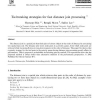21 search results - page 1 / 5 » Tie-breaking strategies for fast distance join processing |
DKE
2002
13 years 4 months ago
2002
The distance join is a spatial join that finds pairs of closest objects in the order of distance by associating two spatial data sets. The distance join stores node pairs in a pri...
MDM
2009
Springer
13 years 11 months ago
2009
Springer
Abstract—Flash disks have been an emerging secondary storage media. In particular, there have been portable devices, multimedia players and laptop computers that are configured ...
ICDM
2002
IEEE
13 years 9 months ago
2002
IEEE
The similarity join has become an important database primitive to support similarity search and data mining. A similarity join combines two sets of complex objects such that the r...
ICDE
2008
IEEE
14 years 5 months ago
2008
IEEE
In data integration applications, a join matches elements that are common to two data sources. Often, however, elements are represented slightly different in each source, so an app...
DASFAA
2006
IEEE
13 years 10 months ago
2006
IEEE
An important database primitive for commonly used feature databases is the similarity join. It combines two datasets based on some similarity predicate into one set such that the n...



